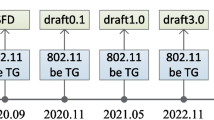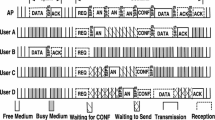Abstract
In recent years, with the increasing number of terminal connections, high-density deployment scenarios have become important scenarios for future wireless networks. Ultra-high throughput (EHT) in high density deployment scenarios is the technical goal of IEEE 802.11be, the next-generation wireless local area network (WLAN) standard. However, in a high-density deployment scenario, interference suppression between BSSs is serious, which seriously affects the throughput of a WLAN. And the resources available are limited. Therefore, for the next generation WLAN standard, this paper proposes a downlink transmission scheme based on AP coordination and the orthogonal frequency division multiple access (OFDMA) protocol and the non-orthogonal multiple access (NOMA) protocol, named Co-OFDMA–NOMA scheme. The core idea is to transform the interference and suppression relationship between neighboring BSSs into the relationship of mutual coordination and assistance through the Co-OFDMA–NOMA protocol proposed in this paper. Firstly, a downlink transmission scheme named the Co-OFDMA–NOMA protocol is designed. In addition, the protocol and its framework structure have good backward compatibility. Theoretical analysis shows that the proposed Co-OFDMA–NOMA protocol has significant performance gain, and simulation results prove the effectiveness of the scheme.















Similar content being viewed by others
Data Availability
Data sharing not applicable to this article as no datasets were generated or analysed during the current study.
References
Cisco visual networking index: Global mobile data traffic forecast update, 2017–2022. Technical report, 2019.
Ericsson mobility report: Experiences from smart fixed wireless access deployment. Technical report, 2019.
IEEE 802.11ax Proposed Draft Specification.http://www.tp-ontrol.hu/index.php/TP Toolbox, 2016.
IEEE 802.11ax (D3.0) Draft standard for information technology telecommunications and information exchange between systems local and Metropolitan area networks specific requirements-part 11: Wireless LAN medium access control (MAC) and physical layer (PHY) specifications, 2018.
Liu, Y., Qin, Z., Elkashlan, M., et al. (2018). Non-orthogonal multiple access for 5G and beyond. Proceedings of the IEEE, 105(12), 2347–2381.
Ding, Z., Peng, M., & Vincent, H. (2015). Cooperative non-orthogonal multiple access in 5G systems. IEEE Communications Letters, 19(8), 1462–1465.
Li, X., Ma, W., Luo, L., et al. (2018). Power allocation for NOMA system in downlink, ** Tong Gong Cheng Yu Dian Zi Ji Shu. Systems Engineering and Electronics, 40(7), 1595–1599.
Cao, S., Yang, Z., & Feng, Y. (2017). New NOMA power allocation strategy, Tong **n Xue Bao. Journal on Communications, 38(10), 157–165.
Islam, S., Avazov, N., & Dober, O. (2017). Power-domain non-orthogonal multiple access (NOMA) in 5G systems: Potentials and challenges. IEEE Communications Surveys and Tutorials, 19(2), 721–742.
Wang, C., Chen, J., & Chen, Y. (2016). Power allocation for a downlink non-orthogonal multiple access system. IEEE Wireless Communications Letters, 5(5), 532–535.
Alabbsai, Z., & Daniel, K. (2015). Power allocation for sum rate maximization in non-orthogonal multiple access system. In 2015 IEEE 26th international symposium on personal indoor and mobile radio communications-(PIMRC): Mobile and wireless networks.
Oviedo, J., & Sadjadpour, H. (2016). A new NOMA approach for fair power allocation. In 2016 IEEE conference on computer communications workshops (INFOCOM WKSHPS).
Datta, S., & Kalyanasundaram, S. (2016). Optimal power allocation and user selection in non-orthogonal multiple access systems. In IEEE wireless communications and networking conference (WCNC 2016) MAC and cross layer design.
Kheirkhah, P. S., Pirayesh, H., Yan, Q., et al. (2020). Power allocation for DL NOMA in multi-beam LEO satellite communication system. IEEE Transactions on Communications, 68(4), 2236–2250.
Han, S., Huang, Y., Meng, W., et al. (2019). Optimal power allocation for SCMA downlink systems based on maximum capacity. IEEE Transactions on Communications, 67(2), 1480–1489.
Chen, J., Wang, Z., **ang, W., et al. (2018). Outage probability region and optimal power allocation for uplink SCMA systems. IEEE Transactions on Communications, 66(10), 4965–4980.
Bo, Y., Shotaro, K., Koji, Y., et al. (2017). Starvation mitigation for dense WLANs through distributed channel selection: Potential game approach. In 2017 14th IEEE annual consumer communications and networking conference (CCNC) (pp. 548–553).
Qu, Q., Li, B., Yang, M., et al. (2019). Survey and performance evaluation of the upcoming next generation WLANs standard—IEEE 802.11ax. Mobile Networks and Applications, 24(5), 1461–1474.
Yang, M., Li, B., & Yan, Z. (2020). MAC technology of IEEE 802.11ax: Progress and tutorial, mobile networks and applications.
Bellalta, B., & Kosekszott, K. (2018). AP-initiated multi-user transmissions in IEEE 802.11ax WLANs, ad hoc networks.
Kyuhaeng, L. (2019). Performance analysis of the IEEE 802.11ax MAC protocol for heterogeneous Wi-Fi networks in non-saturated conditions. Journal of Sensors, 19(7), 1540–1559.
Kiryanov, A., Krotov, A., Lyakhov, A., et al. (2019). Algorithm for dynamic power control and scheduling in IEEE 802.11ax infrastructure networks. Journal of Communications Technology and Electronics, 64(8), 900–909.
Ericsson. (2019). The power of 5G is here and will continue to spread across the globe in the coming years, Ericsson mobility report.
Qiao, J., He, Y., & Shen, X. (2018). Improving video streaming quality in 5G enabled vehicular networks. IEEE Wireless Communications, 25(2), 133–139.
Fan, Q., Yin, H., Min, G., et al. (2018). Video delivery networks: Challenges, solutions and future directions. Computers and Electrical Engineering, 66, 332–341.
Zhao, G., Imran, M., Pang, Z., et al. (2019). Toward realtime control in future wireless networks: Communication control co-design. IEEE Communications Magazine, 57(2), 138–144.
Cariou, L., Stacey, R., Cordeiro, C., et al. (2019). 802.11be timeline proposal. doc.: IEEE 802.11-19/0787r2. IEEE TGbe Proposal (pp. 1–16).
Kheirkhah, S., Pedram, P., Hossein, Y., et al. (2020). A practical downlink NOMA scheme for wireless LANs. IEEE Transactions on Communications, 68(4), 2236–2250.
Ghazi, H., & Wesolowski, K. (2019). Improved detection in successive interference cancellation NOMA OFDM receiver. IEEE Access, 7, 103325–103335.
Su, S., Chih, T., & Wang, Y. (2019). Application of power control to improve system throughput in IEEE 802.11 WLAN. In 2019 11th international conference on computational intelligence and communication networks (pp. 46–52).
Kyungseop, S., & Ohyun, J. (2017). Joint scheduling and power allocation using non-orthogonal multiple access in directional beam-based WLAN systems. IEEE Wireless Communications Letters, 6(4), 482–485.
Uddin, M. (2019). Throughput performance of NOMA in WLANs with a CSMA MAC protocol. Wireless Networks, 25(6), 3365–3384.
Tian, Z., Wang, J., Wang, J. (2017). More clients connected by NOMA in the downlink transmission of WLANs. In 2017 13th international wireless communications and mobile computing conference (pp. 1968–1973).
Acknowledgements
This work was supported in part by the National Natural Science Foundations of CHINA (Grant Nos. 61871322, 61771390 and 61771392), and Science and Technology on Avionics Integration Laboratory and the Aeronautical Science Foundation of China (Grant Nos. 20185553035 and 201955053002).
Author information
Authors and Affiliations
Corresponding author
Additional information
Publisher's Note
Springer Nature remains neutral with regard to jurisdictional claims in published maps and institutional affiliations.
Rights and permissions
Springer Nature or its licensor (e.g. a society or other partner) holds exclusive rights to this article under a publishing agreement with the author(s) or other rightsholder(s); author self-archiving of the accepted manuscript version of this article is solely governed by the terms of such publishing agreement and applicable law.
About this article
Cite this article
Zhenzhen, Y., Bo, L., Mao, Y. et al. Downlink AP coordination based OFDMA and NOMA protocols for the next-generation WLANs. Wireless Netw (2023). https://doi.org/10.1007/s11276-023-03275-y
Accepted:
Published:
DOI: https://doi.org/10.1007/s11276-023-03275-y




